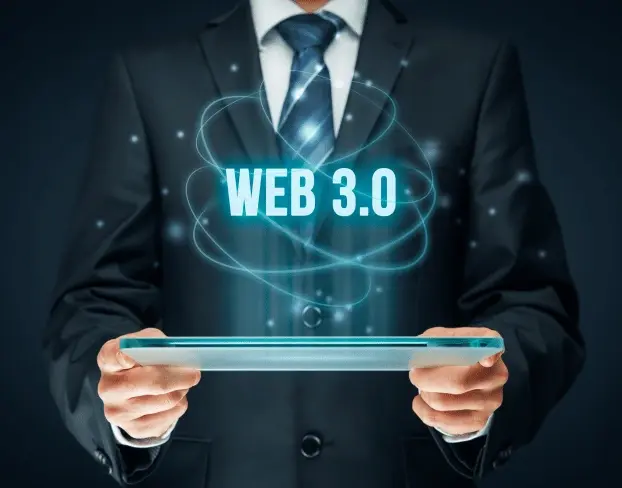- Home
- -Blog
An Introductory Look at Web 3.0 and Essential Buzzwords

- 26 July 2023
- Admin
An Introductory Look at Web 3.0 and Essential Buzzwords
In this article, we will outline Web 3.0, how cryptocurrency fits into the evolution of the current internet, and what it means for you. It should be noted that Web 3.0 is not defined in any way, but we will strive to understand it, and how it is evolving and refining our existence remarkably.
Web 1.0.
In the early days of the Web, static images were the main part of the site, meaning that it displayed some stuff and then that was it, they called it read-only. At the time of the early internet, there was no logging in, no interacting with posts, no analytics, and most of the sites weren't even profitable by ads, but more like a large Wikipedia writing service, all linked together.
Web 2.0.
By introducing Web 2.0, interactive web applications, Marketplaces, user-generated content, and social media platforms would be possible. With Web 2.0 comes targeted advertising and insufficiency of privacy for users; many of the industry's giant partakers are coming under pressure over their use of personal data and targeted advertising. Web 2.0 applications like Facebook and Instag ram made money by collecting the data you gave them carelessly.
So, what is Web 3.0? Web 3.0 is the next wave of the internet; it is an internet of value in which digital ownership of things is made possible by blockchain technology. Decentralization and interoperability are promoted by these technologies. Through Web 3.0, ownership of data will change dramatically, as participants will actually be able to control the data they provide or even benefit directly from it. There are a lot more benefits associated with it, such as censorship resistance, transparency, and trustlessness.
With Web 3.0, the internet as we see it can be completely changed, and we're already starting to see existing things like social media moving toward a Web 3.0 paradigm. With the changing paradigm of technology, power is largely placed in the hands of consumers rather than big tech companies. There are many Web 3.0 applications available today, such as cryptocurrency, NFTs, and decentralized finance or Defi.
Here are some of the most important terms that everyone will need to know to make the transition to Web 3.0 seamless
Metaverse-A metaverse is a virtual space that allows people to interact in a way that is more fascinating than a conventional website. Through the use of virtual reality, a virtual environment is created where an avatar a little cartoon representing yourself can walk around and interact with other people's avatars.
Blockchain- Blockchain is a global online database, The data in the blockchain is not revertable, it is stored forever, and anyone with an internet connection can view it. Unlike traditional databases, which are owned by central figures like banks and governments. A blockchain doesn't belong to anyone, and with an entire network looking after it, cheating the system by faking documents, transactions, and other information becomes near impossible.
Cryptocurrency ("crypto")- Nowadays, blockchain API a digital currency that's decentralized and based on cryptography. The benefit of cryptography is that it is decentralized, so it is not controlled by monetary authorities such as banks or governments. The cryptocurrency can be created by anyone (mined), bought, sold, and traded without restrictions. Modern traders buy crypto with PayPal to quickly enter the market through familiar payment methods while maintaining transaction security. This makes transactions much safer and faster than with traditional currency.To help manage and monitor these assets, many traders rely on a crypto portfolio tracker to keep track of their investments and performance.
MetaMask: In general, MetaMask is a piece of software that simplifies and streamlines the process of interacting with a blockchain. The MetaMask software automates the entire coding process, all you have to do is to click a few buttons. Whether as a smartphone app or a web browser extension, it functions as a crypto wallet and portal to blockchain applications.
Gas Fee- How much cryptocurrency miners receive from users in return for integrating their transactions into the blockchain.
NFT- also known as non-fungible token is a unique token kept in a blockchain and represents digital investments like music, images, 3D models, Gifs, etc. The term nonfungible refers to its unique and non-transferable nature.
Smart contract- In simple terms, smart contracts are programs that run on a blockchain when certain conditions are met. They are generally used to automate the execution of agreements so that all participants know the outcome immediately without a middleman's involvement or wasting any time.
DApp- Decentralized applications - are computer programs that run inside a blockchain network of computers instead of relying on a single computer. Due to their decentralized nature, DApps are immune to the influence and control of singular authorities
Defi - also known as Decentralized Finance - is an emerging financial technology that eliminates the need for central banks or central governments. A broad term for a variety of financial applications involving crypto or blockchain.
Conclusion
In Web 3.0, the user is free to reclaim their personal data, and the internet provides similar advantages to all users, where 3D graphics, IoT devices, artificial intelligence, and virtual and augmented reality, among other things, are fundamental to creating this new kind of decentralized environment. Thus, the importance of Web 3.0 can be attributed to its decentralized architecture.



